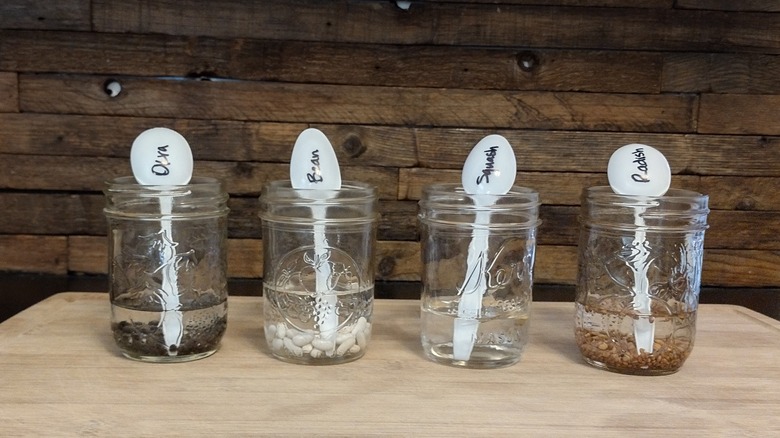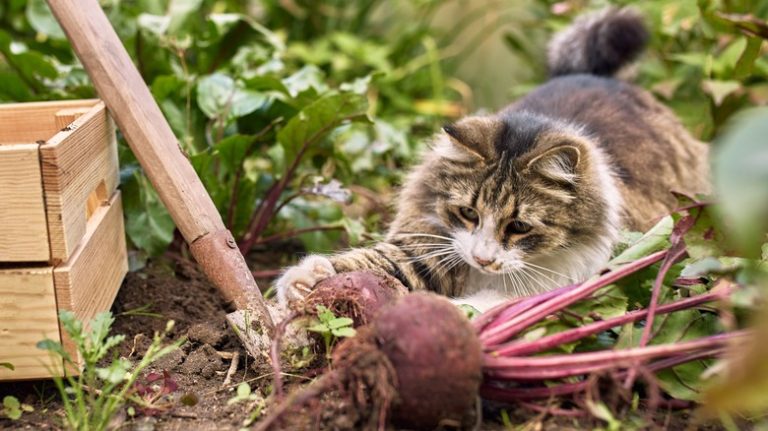We are inspired by hacks that help us grow a better garden. Whether they’re time-saving, plant-saving, or just kind of cool, we are willing to try them. For example, who came up with the idea that milk mixed with water could help manage powdery mildew? That must have taken quite a bit of trial and error! When we heard that vinegar could speed up the seed germination process, we thought it would make a great experiment. If it worked, it could cut down germination time considerably. If not, well, at least we gave it a shot.
It makes sense that vinegar could help seeds germinate. Some seeds, like okra, squash, and beans, have a harder outset shell than lettuce, radish, and spinach seeds. This means it takes longer for them to sprout. We have had luck getting faster germination rates in the past by soaking our harder seeds overnight in regular tap water. We even soaked our seeds in milk one year because the enzymes are supposed to help break down that outer casing. We couldn’t tell the difference between using milk and water, so we continued to soak some of our seeds in water before planting, but we wanted to know if vinegar might be more effective, so we tried it out.
Preparing the seeds

To get started, we mixed 1 teaspoon of white vinegar with 1 cup of tap water in small canning jars. We added our seeds and let them soak for exactly 6 hours before rinsing them thoroughly. Then, we left them out overnight in the jar to dry out a little before planting them in our seed-starting container. Even though we only used a total of 4 teaspoons of vinegar, the smell in our kitchen would best be described as pungent.
If we were to try this process again, we would soak our seeds outside or make sure we have lids. From the time we started soaking the seeds to well after we planted them, our kitchen was not a pleasant place to be — more about that in a bit. Although we rinsed and strained the seeds, they kept the strong odor of vinegar. Clearly, they had absorbed this acidic liquid, and we hoped that would be a good sign.
Getting set up
Because we wanted to keep the variables to a minimum, this experiment was done in our kitchen. This space is consistently around 70 degrees Fahrenheit and 50% humidity, according to our smart thermostat. We bought new seeds for the best possible germination rates. Instead of planting outside, where we have no control over the weather or sneaky squirrels, we treated the process as if we were starting seeds indoors before transplanting. Using a large salad container and fresh soil, we planted four kinds of seeds: radish, squash, okra, and beans. We made small trenches in our soil, spread the vinegar-soaked seeds, and covered them back up.
We added enough water to keep the soil moist but not too wet. To try to prevent the growth of mold and damping off, we left the container top open to allow for some airflow. We placed the container under the grow light, keeping it on from about 7 a.m. to 7 p.m. daily to give our little seeds plenty of pseudo sunlight. Then, we waited eagerly for signs of sprouts.
Observing the growing process
Tiffany Selvey/Static Media
One thing we noticed right away was that planting the seeds did not fully get rid of the odor. Our kitchen still had a slight vinegar smell, but it had turned more sour than pungent. That lasted for a few days before we noticed something very interesting — at each end where the radish and bean seeds were planted, mold was quickly growing. Mold is not an unusual part of the seed-starting process, but we suspected that this much mold growing at this rate meant our seeds were already rotting. Indeed, we discovered shriveled, rotten bean seeds in our post-experiment autopsy.
As we were about to give up on this process, we were pleased to see okra seeds sprouting on days 8 and 9, but sadly, the cotyledons — the first leaves — never made it out of their casing. As quickly as they sprouted, they appeared to rot at the base. Perhaps the soil was too acidic for the young seedlings to survive. We aren’t sure why they didn’t make it. At this point, we had reached day 10 with no positive results, but on the 11th day, a single squash seedling emerged. We kept waiting for it to rot, but it has been five days, and it is showing no signs of rot. It seems that a single squash seedling was the only survivor of our experiment.
Results
Tiffany Selvey/Static Media
Unsurprisingly, the radishes didn’t sprout or thrive since they have a thin outer coat, but we were shocked at how quickly they rotted and molded. It was a surprise that the beans reacted the same way since we normally soak them in water overnight before planting. It seems they tolerate water but not acid. Perhaps the biggest shock in this experiment was the okra. We assumed that if any seedling would benefit from the acid of vinegar, it would be the hard outer casing of okra. It’s possible that if these seeds had been soaked in vinegar and then placed outside where regular watering and rain would flush out excess acid, they wouldn’t have rotted. But that’s an experiment for another time.
Since the squash seed grew well, it seems there might be some truth to the concept that vinegar can help break down the outer casing of some seeds; however, there is no proof that it speeds up the process. Our squash sprouted in 12 days, but regular germination rates for these seeds are 7 to 14 days. We also had exceptionally low germination rates. Of the many seeds we planted, only three sprouted, and one survived. Ultimately, we have decided to avoid the stinky kitchen and stick to soaking our seeds in water before planting.


